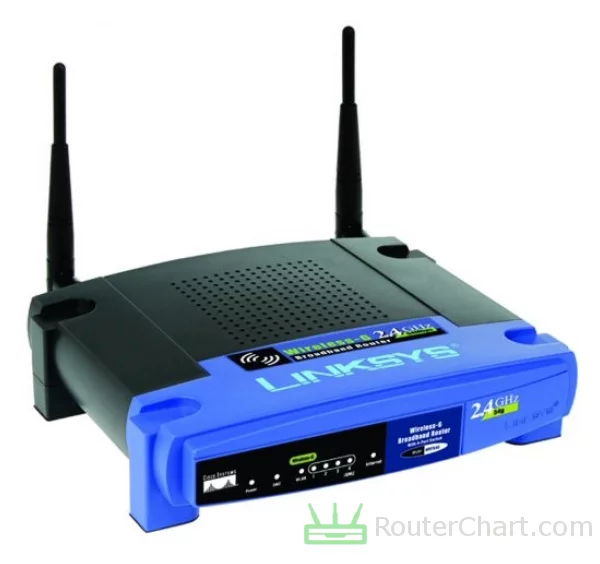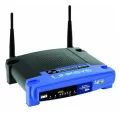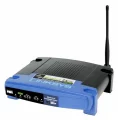Linksys WRT54GL v1.1 router review
Linksys introduced the WRT54GL v1.1 router in 2005. It is powered by Broadcom BCM5352E @ 200 MHz chipset, 16 MB of RAM, and 4 MB of flash memory.
Wondering if this router is a hit? Keep reading to know!
Table of Contents
- Linksys WRT54GL v1.1 specifications
- Body, dimensions, weight
- System, chipset, RAM, flash, power supply
- Network, protocols, WAN and LAN ports
- Wireless, antennas, speed, security
- Connectivity
- Administration, user interface, login information
- Links
- Verdict, Pros and Cons
- Photos
- Comparisons
Our personal experiences and opinions form the basis of this article. We aimed to share insights on a topic, and we hoped others would find it useful and inspirational. If you noticed any mistakes or missing details about the Linksys WRT54GL v1.1, please let us know.

If you need more features, you may want to consider better Linksys routers. Linksys incorporates energy-efficient features into its products, promoting sustainability and reducing power consumption.
Linksys WRT54GL v1.1 specifications
| Brand | Linksys |
|---|---|
| Name | WRT54GL v1.1 |
| Type | WRT54GLV11 |
| Rating | |
| Launch | 2005 |
Body
| Dimensions | 186 x 48 x 154 mm |
|---|---|
| Weight | 482 g |
If you plan to move a lot and need to take your router with you, the size is important. Otherwise, the size isn't too crucial. The weight of a router can matter in some situations. But it's usually not as crucial as other factors.
System
| Chipset | Broadcom BCM5352E @ 200 MHz |
|---|---|
| RAM | 16 MB |
| Flash | 4 MB |
| OS | Linksys |
| Alternative OS | OpenWRT DD-WRT Gargoyle |
| Power supply | 12 V / 1 A |
The Broadcom BCM5352E @ 200 MHz CPU provides processing power. The amount of RAM in a router affects its performance and ability to handle tasks and traffic. OpenWrt offers many customization options. They let users change and tailor their router's functions to their needs.
Network
| Protocols | IPv4 |
|---|---|
| LAN ports | 4 x 10/100 Mbps |
| WAN ports | 1 x 10/100 Mbps |
| Mobile network | no |
| VPN support | no |
The WRT54GL v1.1 features a Fast Ethernet WAN port that has a maximum speed of 100 Mbps.

Wireless
| Antennas | 2 x 2 dBi RP-SMA |
|---|---|
| 2.4 GHz | yes |
| 5 GHz | no |
| 60 GHz | no |
| Standards | IEEE 802.11b/g |
| Class | G54 |
| Speed | 54 Mbps |
| Transmit power | 18 dBm |
| Security | WEP WPA WPA2 |
| Guest network | no |
The 2.4 GHz band is widely supported by many devices. 802.11g routers have a 54 Mbps max data rate. This is much slower than newer Wi-Fi standards. The introduction of WPA2 (Wi-Fi Protected Access 2) improved upon WEP. It provides stronger security.
Connectivity
| USB ports | no |
|---|---|
| Print server | no |
| File server | no |
The WRT54GL v1.1 router doesn't have file-server or print-server functionality.
Administration
| Default IP | 192.168.1.1 |
|---|---|
| Default username | [blank] |
| Default password | admin |
If you can't log in to your Linksys router's setup panel, try resetting it. A reset can help you troubleshoot. It is highly recommended to change the default password of your WRT54GL v1.1 router. Do this after the initial setup.
Links
| Official site | https://www.linksys.com/ |
|---|
Pros and Cons
Every router, including this Linksys one, has its good sides and not-so-good sides. Let's take a closer look at both to get a full understanding of what this router can do. Just remember, this is just what I think, and you might see things differently.
Pros
- OpenWrt compatible
Cons
- insufficient memory
- insufficient flash
- lack of Gigabit LAN
- Non-gigabit WAN port
- missing Wi-Fi 6 support
- lacks Wi-Fi 5 compatibility
- reduced Wi-Fi bandwidth
- incompatible with WPA3
- missing WPS support
- no USB connectivity
Linksys WRT54GL v1.1 photos



Linksys WRT54GL v1.1 comparisons
We've noticed that many of our visitors like to compare the Linksys WRT54GL v1.1 router with these popular models.
If there’s information about the Linksys WRT54GL v1.1 that you would like to see on this site, then write to us.
Updated: May 25, 2024




